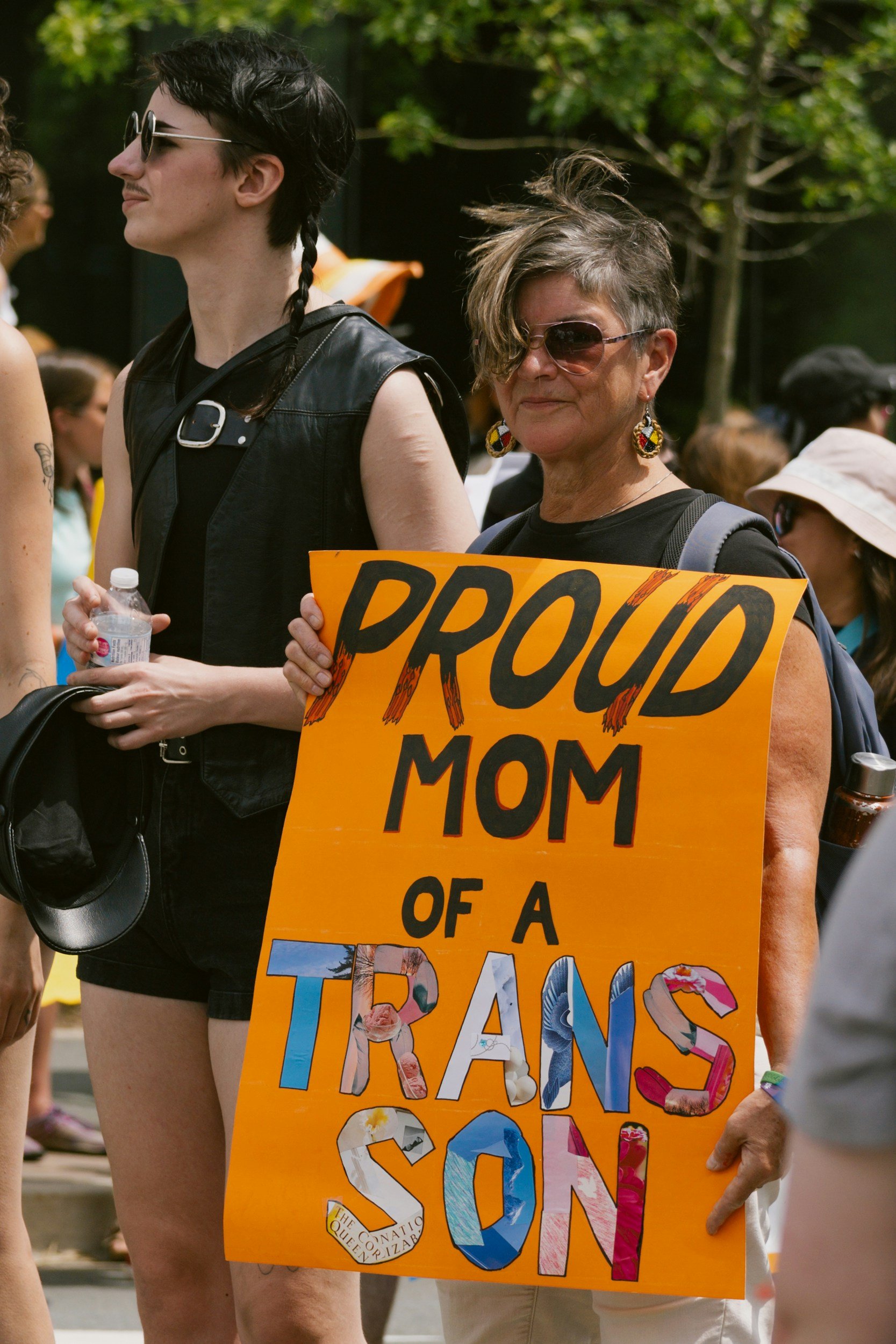How to Support LGBTQ+ Youth
5 Steps That Go Beyond Rainbow Flags
We are living in a time where it is critical to move beyond small gestures and take meaningful action to support LGBTQ+ youth. Whether you're a parent, educator, social worker, or simply an adult who cares about young people, now is the time to step up and let our support be seen and heard by them and by all the other people around us. Here are five concrete steps that go beyond rainbow flags to truly support LGBTQ+ youth.
Step 1: Understand the Current Political Climate and Its Impact
To effectively support LGBTQ+ youth, we must first understand what they're facing in today's political environment. The landscape is increasingly hostile, with numerous laws and policies directly impacting their lives and wellbeing.
Attacks on Gender-Affirming Care
Gender-affirming care encompasses medical, mental health, and surgical support provided to people whose gender identity doesn't match their biological sex. This vital medical care helps trans and non-binary folks feel more alignment between their gender identity and their body. For young people, this can includes hormone blockers as they enter puberty, but can encompass a spectrum of medical and mental health care.
Life-saving gender affirming care is currently under attack across the United States. As of May 2025:
27 states have enacted laws or policies limiting youth access to gender-affirming care
40% of trans youth (ages 13-17) live in states that have restricted this care
17 states are facing lawsuits challenging these laws or policies
24 states impose professional or legal penalties on healthcare providers who provide gender-affirming care to minors
Disregard of Pronouns
As of June 2023, at least 10 states have passed laws allowing teachers to disregard students' requested pronouns or requiring parental permission to use pronouns matching their gender identity. In at least six of these states, teachers and administrators are required to tell parents if a young person requests a name or pronouns that do not align with their sex assigned at birth. For youth with unsupportive families this is extremely dangerous.
It’s also particularly devastating because it removes safe spaces where young people without supportive homes could previously ask trusted school staff to affirm their identities. The impact is significant: according to a 2020 Trevor Project study, trans and nonbinary youth who have their pronouns respected by all or most people in their lives attempt suicide at half the rate of those who don't have their pronouns respected. It’s a small thing to use someone’s correct pronouns but it can truly life saving.
Source: Pronouns for Trans, Nonbinary Students: The States With Laws That Restrict Them in Schools (June 2023) and National Survey on LGBTQ Youth Mental Health 2020
Restrictions on Inclusive Curriculum
We have also seen attacks on curriculum in schools that support or even acknowledge the existence of LGBTQ+ people. Between 2021 and 2024, 7 states enacted laws requiring parental notification of LGBTQ+ inclusive instruction which allows parents to opt their child out of instruction that includes LGBTQ+ topics. Additional restrictions include:
11 states have laws censoring instruction on LGBTQ+ people and topics
8 states passed "Don't Say Gay or Trans" laws prohibiting instruction on sexual orientation and gender identity
2 states restrict access to LGBTQ+ inclusive school library books
15 states censor instruction on race and sex-based structural inequity in K-12 schools
This data is from 2024 and with the current political climate, it seems inevitable that the restrictions will continue to worsen.
Source: GLSEN Navigator: Inclusive Curricular Standards Policies (Last updated December 13, 2024)
Executive Orders
Since the 2025 inauguration, numerous executive orders have further impacted LGBTQ+ youth through:
Erasure of LGBTQ+ people by preventing data collection on gender identity and sexual orientation
Loss of funding for programs addressing unique health needs of LGBTQ+ people
Conditional federal funding for schools based on their support of transgender students
Funding cuts to NGOs and research on LGBTQ+ supportive topics
While the legality of the Executive Orders is still being litigated in court, many states and schools have proactively implemented these restrictions or used them as justification to remove existing protections for LGBTQ+ youth. Consequently, these action will exacerbate existing mental health disparities, continue to perpetuate stigma and discrimination, and reduce the availability of safe spaces that so many young people need.
Source: KFF: Overview of President Trump’s Executive Actions Impacting LGBTQ+ Health (May 29, 2025)
Step 2: Stand Up and Educate Others
When encountering people who are hateful or claim they "don't get it," it's crucial to know the facts and make the issue personal. Sharing stories about LGBTQ+ young people in your life—whether your own child, a friend's child, or a young person you’ve worked with—can have tremendous impact.
As Brené Brown says, "People are hard to hate close up.” We need to move towards those who haven’t made the effort to understand LGBTQ+ people or the impact of the laws and policies that harm them. While it can be tempting to continue to separate ourselves, as advocates and allies for young people who have less power and autonomy, it's our job as caring adults to step forward and use our voice and privilege to talk to other adults to try to help them understand what's at stake.
The State of LGBTQ+ Mental Health
The Trevor Project's 2024 U.S. National Survey on the Mental Health of LGBTQ+ Young People revealed statistics that emphasize the important of standing up for LGBTQ+ youth:
Nearly half of LGBTQ+ young people experienced bullying in the past year
39% seriously considered attempting suicide, including 46% of trans and non-binary youth with youth of color having even higher rates than white youth
More than 1 in 10 attempted suicide in the past year
90% said their wellbeing was negatively impacted by recent politics
The impact of current political events is immediate and measurable. On January 20, 2025 (Inauguration Day), the Trevor Project saw a 33% increase in crisis line volume compared to the previous week. The day after Inauguration, volume increased by 46%.
These statistics can, of course, be upsetting but we can make even more of an impact when we are equipped with the right information.
Source: 2024 U.S. National Survey on the Mental Health of LGBTQ+ Young People and The Trevor Project Reported a 33% Increase in Crisis Line Volume on Inauguration Day (Jan 21, 2025)
Step 3: Advocate at Every Level
We need our voices heard as caring adults. This means advocating at federal, state and local levels.
Call your Senate and House representatives to express your support for LGBTQ+ youth protections - 5 Calls is a helpful resources that provides the contact information of your Congresspeople and scripts for what to say
Stay informed about your state legislature, as many restrictive laws originate there by using the ACLU’s resource: Mapping Attacks on LGBTQ Rights in U.S. State Legislatures in 2025
Attend school board meetings and utilize the HRC’s guide, School Boards Matter: A Guide to Effectively Advocating at the School Board Level
Talk to principals and superintendents
Rally like-minded community members
Advocate for supportive policies in schools and local government
Local communities and schools can have enormous impact through the policies they implement, especially during chaotic times at the federal level.
Step 4: Put Your Money Where Your Values Are
Financial support makes a real difference, especially as nonprofits supporting LGBTQ+ youth lose federal funding at alarming rates. Organizations across all sectors are cutting jobs, programs, and research due to budget cuts.
If you're able:
Donate to local organizations supporting LGBTQ+ youth
Support larger national organizations like GLSEN
Volunteer for organizations like The Trevor Project's Crisis Hotline
Every contribution, no matter the size, helps fill critical funding gaps.
I’ve also been learning a lot from my friend Lindsay at Mind, Money, Balance about voting with my dollars and leo aqunio at Queer & Trans Wealth on paying it forward, mutual aid, and how to financially plan for the Trump Administration.
Step 5: Be Vocally and Visibly Supportive
It is incredibly important to understand what a huge impact you can make by simply being vocally supportive of LGBTQ+ young people. Having just one accepting adult in their lives reduces suicide attempt risk by 40%. Just one supportive adult. That can be you - so be sure the LGBTQ+ youth around know you support them.
The 2024 U.S. National Survey on the Mental Health of LGBTQ+ Young People also found that:
Transgender and non-binary youth with gender identity acceptance from adults and peers have lower odds of attempting suicide
LGBTQ+ youth with high family social support attempt suicide at less than half the rate of those with low or moderate support
Youth in very accepting communities attempt suicide at half the rate of those in unaccepting communities
The survey also asked LGBTQ+ young people how people can best show support. Their top five responses were remarkably simple:
Trust that I know who I am - Believe young people when they tell you who they are, even if their identity evolves over time
Stand up for me - Advocate for them in conversations with others. They know when you have their back.
Don't support politicians who advocate for anti-LGBTQ+ legislation - Enough said.
Look up things about LGBTQ+ identities to better understand - Educate yourself so the onus isn’t on the youth to always explain things to you.
Respect my pronouns - This simple act has profound impact.
Source: 2024 U.S. National Survey on the Mental Health of LGBTQ+ Young People
Embrace the both/and
While the challenges facing LGBTQ+ youth are real and serious, it's important to recognize their incredible resilience. LGBTQ+ people have always found ways to create community, care for one another, and build safe spaces. Young people continue to find chosen family, supportive adults, and understanding teachers in the amidst of incredible adversity.
We need to embrace the both/and - that there are both very real dangers these young people face and they possess remarkable strength in navigating an often hostile world. Our job as caring adults is to make their journey safer and ensure they know they're not alone.
The actions outlined here might feel simple, but they're not always easy. However, when young lives hang in the balance, we must use our voices and leverage our privilege as adults to advocate for those who need our support most.
Want to learn more? Read on: LGBTQ+ Youth Spaces: 4 Ways to Affirm LGBTQ+ Identities and subscribe to both/and, a free bi-weekly newsletter for parents and professionals who want to embrace both the delights and the difficulties of adolescence.




